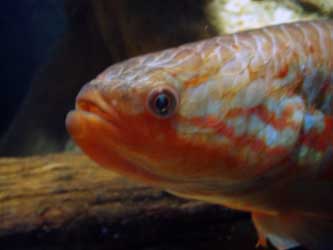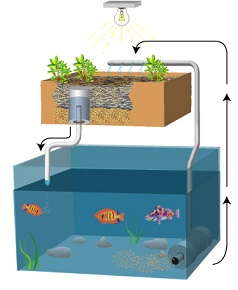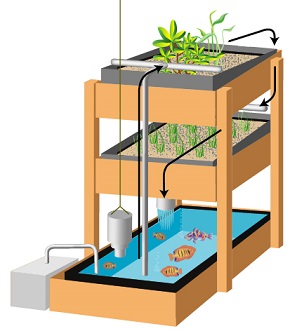Learn about the culture of aquatic organisms with Aquaponics - an exciting blend of Hydroponics and Aquaculture

Aquaponics is the combination of hydroponics with aquaculture in controlled environment, whereby fish waste provides a source of nutrients for plants, and the plants, in turn, provide a filter for the water in which the fish live.
Aquaponics is considered the world’s most productive food system with regards to water use efficiency. Many aquaponics systems only use around half of the volume of water to produce £100 worth of food (fish and vegetables or fruit) than inorganic hydroponics.
Aquaponics is an intensive way of farming that can be conducted anywhere.
- It can produce a great deal more food products per unit of area than more traditional forms of farming.
- It diversifies the income for a grower, making them more resilient to fluctuations in income (e.g. when vegetables are in less demand, fish might be in higher demand. If fish profits drop, vegetable profits may increase).
- It can be viable on any scale, small scale set ups in small home garden can provide for the needs of a single family, while medium size operations on less than a quarter acre can be a viable small business, and large scale operations on many acres, even hundreds of acres can form the heart of a larger business enterprise.
- It can allow food to be produced closer to the end user in areas otherwise unsuited to farming (e.g. in a desert, in inland city areas, etc.). This reduces food miles, expenditure of fuel on food transport, reduces potential pollution, and in turn increases the freshness of food arriving at market.
- It can be more efficient use of water where water resources are limited.
- It can be environmentally friendly, containing and reusing waste, rather than returning it to the environment, and causing pollution.
COURSE STRUCTURE AND LESSON CONTENT
Start at any time - study at a pace that suits you, and with full tutor support for the duration of your studies. The course comprises 10 lessons as detailed, below.
Lesson 1. Introduction
- What is aquaponics?
- History of aquaponics.
- Why aquaponics?
- World food.
- Urban farming.
- Cost benefit analysis.
- Is aquaponics organic.
- The aquaponics system.
- Can it be used with salt water.
- Types of Systems (constant flow closed reciprocating, open, deep water, floating raft).
- Outdoor or indoor systems.
- Barrelponics, wick, NFT, etc.
- Advantages and disadvantages of aquaponics.
- Scale of operation.
Lesson 2. Aquaponic System Options
- Recirculating systems.
- Non-recirculating (open loop systems or microponics).
- Components of commercial fish rearing systems.
- Aquaponic subsystems.
- Deep water culture (DWC).
- Intermittent flow (Ebb and flow).
- Nutrient film technique (NFT).
- Gravel bed systems.
- Barrelponics systems.
- Equipment (commercial and non-commercial).
- System components.
- Tanks.
- Aeration devices.
- Solids removal: clarifiers, solids tanks, filters, screens.
- Biofilters.
- Sump and pH adjustment tank.
- Water heaters and chillers.
- Greenhouse houses and fish rearing facilities.
- Alarm and back up systems.
- Hydroponic grow beds and types of media.
- Maintenance, water monitoring and adjustment.
- Organic vs non organic.
- Combining worms with growing beds.
Lesson 3. The Science of Animal and Plant Growth
- Plant growth factors.
- How plants grow.
- Plant structure (roots, stems, leaves, reproductive parts).
- Biochemistry and aquaponics.
- Biochemical processes in a cell.
- Photosynthesis.
- Mechanisms of nutrient uptake.
- Plant nutrients.
- Role of pH in plant growth.
- Animal science.
- Bony fish (Osteichthyes) and their biology.
- Crustaceans: crabs, lobsters, shrimp and prawns.
Lesson 4. Nutrition and Controlling Growth
- Water soluble chemical compounds (ions).
- Less water soluble chemicals.
- Complex chemical compounds.
- Understanding nutrient formulae.
- Hydroponic nutrient formulae.
- Atoms, elements and compounds.
- How are chemical names written?
- What does a plant need.
- Calculating formulae.
- Mixing nutrients.
- Case study.
- Symptoms of nutrient deficiency.
- Nutrients in aquaponics.
- Variables in aquaponics (conductivity, ph control, oxygenation, beneficial bacteria in aquaponics).
Lesson 5. Selecting and Managing Animal Production: Fish and Crustaceans
- Choosing what to farm.
- Climate.
- Water.
- Finance.
- Scale of operation.
- Other resources.
- Market.
- Availability of animals.
- Risk considerations.
- Overview of main species to grow (in Asia, South Africa, Australia, U.K., Europe, North(Rainbow, Brown).
- Bass.
- Tilapia.
- Catfish.
- Barramundi.
- Carp.
- Mullet.
- Sunfish.
- Eels.
- Marron.
- Other species (ornamental fish, crustaceans and molluscs).
- Sourcing fish and crustaceans.
- Fish food.
- Which type of fish food to use: pellets, live food, daphnia, brine shrimp, tubifex worms, earthworms, oil meals.
- Other food.
- Fish food production (beef heartlegumes, seafood and vegetable mix).
- Earthworms (setting up, adding worms).
- Compost (understanding, making, conditions for compost production).
- Fish health.
- Common pests and diseases in aquaponics.
- Penaeid shrimp diseases.
- Fish diseases.
- Salinity and system health.
Lesson 6. Setting up an Aquaculture System
 Choosing the right sized system.
Choosing the right sized system.- Selecting the right components.
- Setting up the system.
- Getting started.
- Threats to the system.
- Using a greenhouse.
- Greenhouses (passive systems, active systems).
- Active solar heating.
- Greenhouse management.
- Controlling the growing environment.
- Light control.
- Air temperature control.
- Root temperature control.
- Relative humidity and vapour pressure deficit.
- Controlling humidity.
- Carbon dioxide and oxygen.
- Computer controls.
Lesson 7. Aquaponic Plant Culture
- Selecting media for aquaponic plant culture.
- Types of media Growing seedlings.
- Seed sources.
- Sowing seed.
- Seed propagating media.
- Sowing seed direct.
- Vegetables in aquaponics.
- Herbs.
- Successional planting.
- Flow charting a crop.
- Controlling plant growth (stopping, spacing, disbudding, trimming, training).
- Pollination.
- Pest, disease and other crop problems: overview, identification.
- Pest, disease and disorder control in aquaponics.
Lesson 8. Applications and Opportunities
- Aquaponics for profit.
- Economic thresholds.
- Harvest and post harvest management of fish.
- Harvest and post harvest management of vegetables and herbs.
- Harvested crop physiology (fruit ripening, respiration, when to harvest).
- How to prepare salad mixes from harvested vegetables: chlorine levels in water for washing produce, preventing bruising and rots, packaging.
- CA and MA storage Chilling damage and storage temperature.
- Harvesting and grading vegetables.
- Fruit grading systems.
- Marketing.
Lesson 9. Managing an Aquaponics Venture - including a Problem Based Learning Project (PBL - see more below)
- Case study: University of the Virgin Islands system.
- Case study: North Carolina State University system.
- Case study: Speraneo system.
- What is an aquaponic trial?
- Running an aquaponic trial.
- Research methodology.
- PBL Project. Create and present a plan with specific strategies for improving the crop production of an aquaponics system in terms of amount and quality of produce harvested based on a clear understanding of the system’s requirements and its location (greenhouse or open air; temperate, subtropical, or tropical climate).
Lesson 10. Troubleshooting
- Water supply problems.
- pH problems.
- Algae growth.
- Dirty, cloudy water.
- Water imbalances (high levels of ammonia or nitrite).
- Imbalances in gases.
- Fish troubleshooting.
- Controlling salinity and nutrients without damaging fish.
- Plant troubleshooting.
- Diseases.
- Pythium in aquaponics.
- Pests.
- Environmental physiological disorders.
- Nutrition problems in aquaponics.
- Deficiency symptoms.
- Correcting nutrient problems in aquaponics.
- Fruit set management (pollination, floral initiation, fruit growth).
- Flower and fruit development problems.
- Fish eating plant roots.
- Power losses.
- Clogging with sediment.
- Fish to plant imbalances.
- Pathogenic contamination issues.
THE AQUAPONICS SYSTEM

Aquaponic systems can vary greatly in size. They can be as small as an indoor fish tank or a large scale commercial aquaponics system. The type and size of aquaponics system you choose will affect the components and features that you will need to run it. Generally, the main components of any aquaponics system are:
- grow beds;
- fish tank;
- fingerlings tank;
- water pump;
- air pump.
To ensure that a system is functioning at an optimal rate the water temperature, pH, dissolved oxygen, nutrients, salinity, ammonia and nitrite need to be within appropriate levels.
Water temperature – this is vital to the survival of fish. Temperature fluctuations outside of the normal range for fish species can induce shock in fish and possibly lead to death. The climate of your region will influence the heating and cooling you will need.
pH – measure of how acidic or basic the water is. The pH level is usually higher at the beginning of a cycle and then gradually decreases once a system has cycled completely. In general the pH should be between 6.8 and 7.2.
Dissolved Oxygen – dissolved oxygen is required by all fish to survive. The water properties and stocking densities will affect its ability to hold oxygen. For example, warmer water will hold less oxygen.
Nutrients – macro and micro nutrients are needed for healthy plant growth. Plants can grow with limited nutrients, however this will affect their appearance and flavour. They may also be more susceptible to disease without adequate nutrients.
Salinity – non-iodized sea salt is used as macro nutrients and for treating any diseases in fish.
Ammonia – this the first product of the nitrogen cycle. There are two forms of ammonia, unionized ammonia is most toxic to fish.
Nitrite – this is the second product of the nitrogen cycle. Nitrite is produced by the oxidation of ammonia by bacteria and is highly toxic.
HOW THE COURSE WORKS
You can start the Aquaponics course at any time.
It is studied by distance learning, so you can study in the comfort of your own home. But this doesn't mean you are all alone in your studies. Our highly qualified and friendly tutors are there to help you every step of the way. If you have any questions at all, they are always happy to help.
Each lesson includes set tasks, and is completed with an assignment which the student submits to their course tutor. The tutor will mark the assignment and return this to the student with comments and suggestions for further reading.
WHY STUDY WITH ACS?
 ACS offer high quality courses, written and taught by experienced professionals.
ACS offer high quality courses, written and taught by experienced professionals.- You can start our courses at any time, and with different study options (online or eLearning) you can choose when and where you want to study.
- Our principal John Mason, is author of one of the world's best selling hydroponic books.
- We have been teaching and collecting information on hydroponics since the early 1970's.
- Our tutors include Dr Lyn Morgan - an internationally renowned expert on hydroponics, and a consultant who has worked across the world on commercial installations.
- Courses are continually improved – we invite feedback from all graduates and change courses immediately a need is identified.
- Courses are relevant to the whole world – we try hard to take a global perspective and make the learning transferable to any region or country.
BUSINESS AND CAREER OPPORTUNITIES
Study alone can never guarantee career success, but a good education is an important starting point.
Success in a career depends upon many things. A course like this is an excellent starting point because it provides a foundation for continued learning, and the means of understanding and dealing with issues you encounter in the workplace.
STUDENT TESTIMONIAL
We receive many unsolicited comments from students and graduates. A selection of these can be viewed on our student testimonials page.
Chloe Blum, who has completed the Aquaponics courses commented:
"I am loving the course! I have learned so much and can't stop reading the material. My tutors give me great feedback. I believe this has been one of the most rewarding and valuable learning experiences. Not only do I look forward to doing my classes everyday I'm also learning great information for something I am truly passionate about. I believe the layout of each lesson is very helpful and I am surprised how much information I learn from just reading a few pages. I graduated from an online national high school and was so happy when I found this school. I am very satisfied with this type of education. The school has been so helpful and nice! I am also very satisfied with the staff at this school. Anytime I have a question they have been right there to help me along the way. The support is great and it makes my learning experiences even better."
WHAT NEXT?
Register to Study - Go to “It’s Easy to Enrol” box at the top of the page and you can enrol right now.
CHOOSING THE RIGHT COURSE FOR YOU
We understand the importance of choosing the right course. If you have any questions, please use our Free Course Counselling Service to contact a Hydroponics tutor - they will be more than happy to advise you.